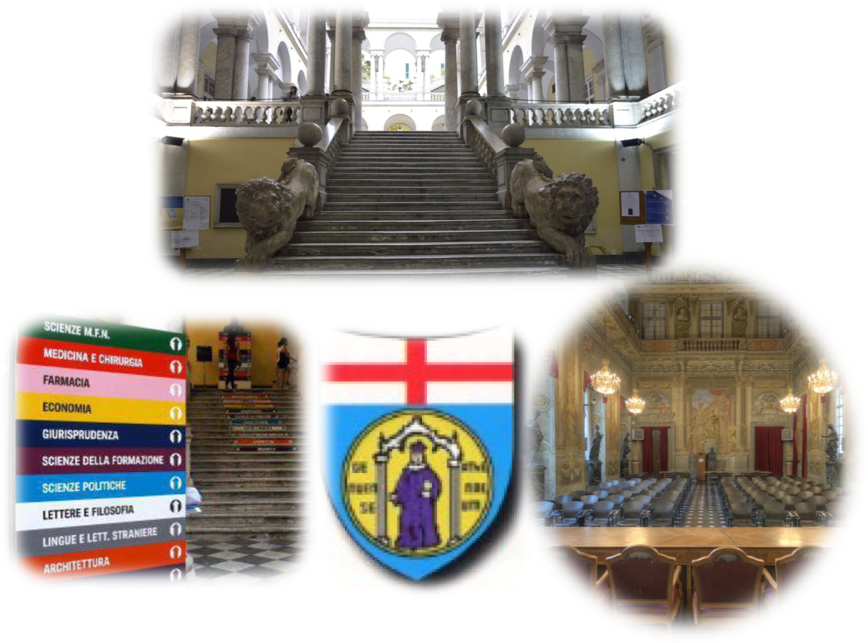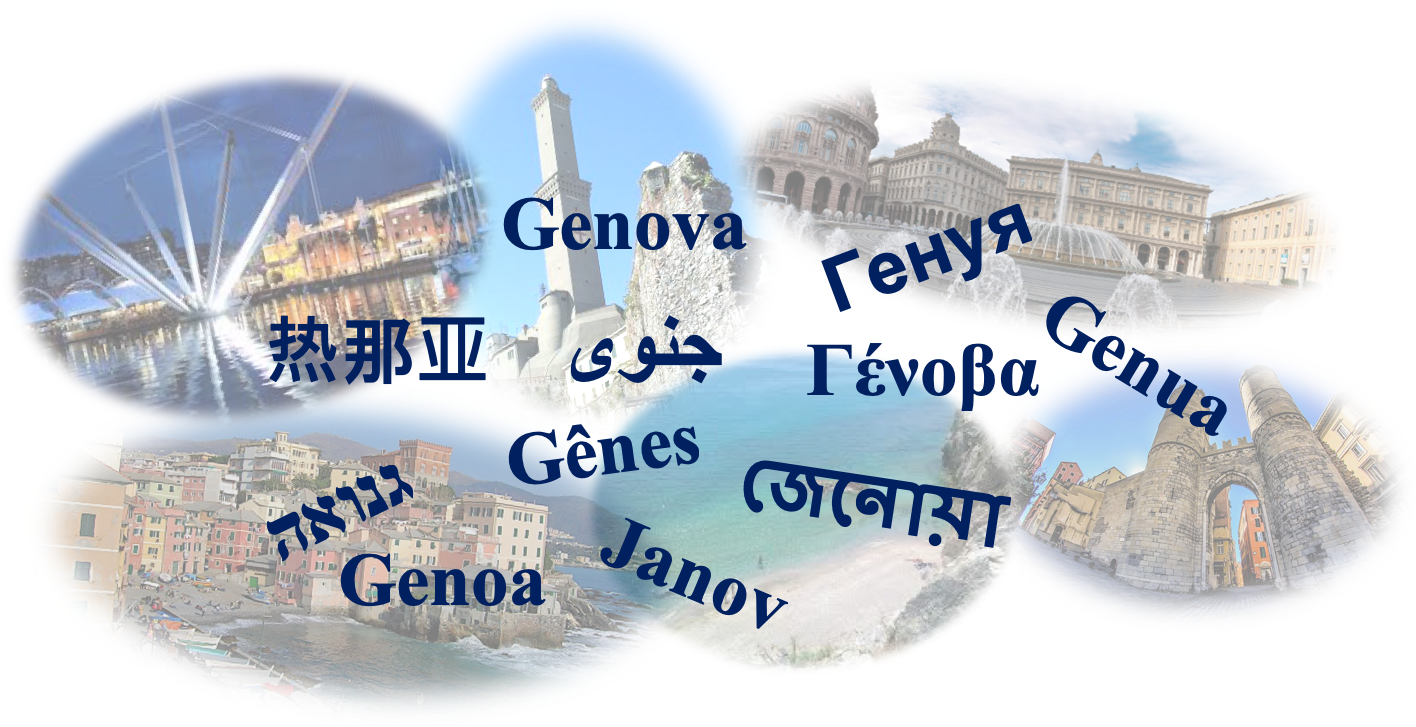The University

The University of Genoa, the only university in Liguria, was founded in 1481 and is one of the oldest European universities. With over 30,000 students, it is part of the 16 “Great” Italian State Universities and is organized in 5 Schools, 22 Departments, 14 Research Centers, 8 Interdepartmental Centers, 14 Interuniversity Centers, 2 Strategic Centers (Sea Center; Center for Security, Risk and Vulnerability) and 1 Center of Excellence (CIELI).
Because of the scientific quality of its 31 PhD Programmes, the University of Genoa is among the best public universities in the MUR national ranking for doctorates. Regarding the PhD Programme in Experimental Medicine, the 22 graduates, who have obtained the PhD degree in the last three years (cycles XXXIII-XXXV), have produced to date 159 publications (on average ~ 7 articles each) on international scientific journals with peer review and medium-high impact index.
The Town
The Historic Center
The heart of Genoa is its Historic Center, a labyrinth of alleys (carruggi) and medieval squares covering an area of over 250 acres. Over the centuries, it has always been a real cultural “melting pot” where people from different social backgrounds, languages and traditions integrate, creating the unique atmosphere that inspired some of the most beautiful songs of Fabrizio De Andrè.
During a walk in the historic center you can see the Cathedral of San Lorenzo (Saint Lawrence), the splendid palaces of the ancient powerful Genoese noble families (e.g. Palazzi dei Rolli declared World Heritage Site by UNESCO), Gothic churches with black & white-striped facades that overlook small squares that have remained unchanged since their construction, towers for the sighting of enemies, ancient walls and old shops.
In the area around Piazza delle Erbe there are a lot of small restaurants, pubs and coffee bars mostly for the young crowd.
The climate and the sea
Thanks to its position by the sea, facing south and sheltered by the mountains to the north, Genoa enjoys a particularly pleasant Mediterranean climate even in winter when the temperature usually varies between 5 and 10 °C along the coast. In summer, sea breezes mitigate the heat and maintain the maximum temperature around 27 °C, with 30 °C only sporadically exceeded.
A few minutes from the city center, both eastward and westward, there are numerous woderful beaches, free and equipped, where you can spend a pleasant day and take a nice bath in the crystal clear sea water.
Among the most suggestive city beaches, there are those of Boccadasse, Vernazzola, Sturla, Priaruggia, Quarto and Quinto to the east, while to the west the bathing beaches are in Multedo, Pegli and Voltri. Moving a little away from the city, but remaining within of approx. 60 miles, there are over 20 beaches accredited with “blue flag”, a symbol of clean coasts and crystal-clear sea, one pride of our region.
Even in winter, it is pleasant to spend a few hours along the sea promenade of Genoa (Corso Italia) or in one of the seaside districts, set in the city coast; the district of Boccadasse is particularly suggestive, animated in the evening by ice cream parlors, pubs, bars and restaurants.
Gastronomy
The most famous typical specialty is certainly the Genoese pesto, a mix of fresh basil, garlic, pine-nuts, parmesan and pecorino cheese, ligurian extra-virgin olive oil and a pinch of coarse salt, traditionally hand-worked in a precise sequence using a marble mortar with a beech wood pestle. This is the ideal sauce to taste “troffie” (short, twisted home-made pasta), “trenette” (a kind of flat spaghetti) or “mandilli” (very thin pasta handkerchiefs), but the lovers of first courses can also try the “pansoti” (a ravioli-like fresh pasta stuffed with wild herbs) with a walnut sauce or the “corzetti” (small discs of fresh pasta) with a pine nut sauce. Among the main courses, there are a lot of traditional specialties such as cima, cappon Magro, stockfish Genoese style, rabbit Ligurian style, and a great variety of other meat and fish dishes (other examples here). The Genoese pandolce is instead the typical Christmas cake.
For the lovers of street food, bakeries continuosly churn out trays of the famous genoese “focaccia”, excellent at any hour but when soaked in a cappucino at breakfast it is an explosion of flavours you must experience.
Equally famous and mouth-watering are “farinata” (a kind of thin salty pancake made with chickpea flour) and the Recco cheese focaccia that the whole world envies us.
Genoa: city of theatres
The Theatre Carlo Felice is the city Opera House and offers a high-level Opera and Symphonic season every year.
The National Theatre of Genoa is the new city reality born from the union between the “Teatro Stabile” of Genoa and the “Teatro dell’Archivolto”, and represents one of the most important cultural institutions of the city, which currently operates in four rooms: the Teatro della Corte, the Teatro Duse, the Teatro Gustavo Modena and the Sala Mercato.
Another important theatre is the “Teatro della Tosse”, a crossroads for artists and companies from all over the world, which offers the public a meeting place full of news and cultural stimuli. Also, the “Politeama Genovese” that since 1821 offers comic theater, prose, comedy, musicals, dance, and civil theater. Finally, many small theatres, not only in the city center but also in the suburbs, offer quality shows ranging from musicals to dialect theatre.
The Old Port and the Acquarium
The “Porto Antico” (Old Port) is a waterfront area of the port of Genoa that was restored and renovated by the architect Renzo Piano on the occasion of the 1992 Expo, which celebrated the 500th anniversary of Christopher Columbus’ discovery of America. Today, it is an important tourist and cultural center with various structures dedicated to many initiatives (Magazzini del Cotone, Millo, Mandraccio, Porta Siberia), surrounded by restaurants, pizzerias, ice cream parlors, breweries and the multiplex cinema “The Space”.
At the center of the complex, dominated by the panoramic Bigo lift, there is “Piazza delle Feste” (Party Square) which features a multifunctional tensile structure where cultural, musical, sport and commercial events are hosted, and which becomes a large ice skating rink during the winter.
The Genoa Aquarium, also designed by Renzo Piano, is the largest in Italy, the first in Europe for the number of animal species (12,000 animals from 600 different species) and with its 27,000 m2 it is third in Europe and ninth in the world. You can see the nice manatees, attend dolphin training sessions, observe sharks closely, admire the plastic evolution of the seals or the funny penguin waddling, be fascinated by the world of jellyfish and much, much more.
From April to September, you can also live the fascinating experience of the many sightseeing boat trips sailing from the old port to visit some of the most beautiful places of the Liguria coast, such as Portofino, San Fruttuoso, Vernazza, Monterosso or Portovenere. In addition, you can visit the Cetacean Sanctuary in the Ligurian sea where whales and dolphins can be seen in their home habitat.
The Museums
Genoa offers a great variety of Museums.
In the Museums of Strada Nuova (Palazzo Bianco, Palazzo Rosso, Palazzo Tursi) and in the Galleria di Palazzo Spinola, for example, you can admire works by the most prestigious Italian and European painters from the 16th to the 18th century – from Caravaggio and Veronese to Rubens and Van Dyck – in the splendid setting of sumptuous noble palaces.
The Museum of Oriental Art “Edoardo Chiossone” exhibits a valuable collection of Japanese and Chinese art, while an important collection of contemporary Italian and international art is housed in the Villa Croce museum.
In the basement of the Cathedral of San Lorenzo there is the Museum of the Treasure of the Cathedral where, in addition to masterpieces of gold and sacred art, there are evocative pieces such as the Sacred Catino which, according to legend, is the authentic Holy Grail.
The “Giacomo Doria” Civic Museum of Natural History is known worldwide for its outstanding collection with some four million specimens from all over the world.
The “Galata Museo del Mare”, a three-storey glass and steel building with a terrace designed by the Spanish architect Guillermo Vasquez Consuegra, is a museum dedicated to the history of navigation and during the visit it is possible to board the submarine S518 Nazario Sauro to experience the living conditions of submariners.
